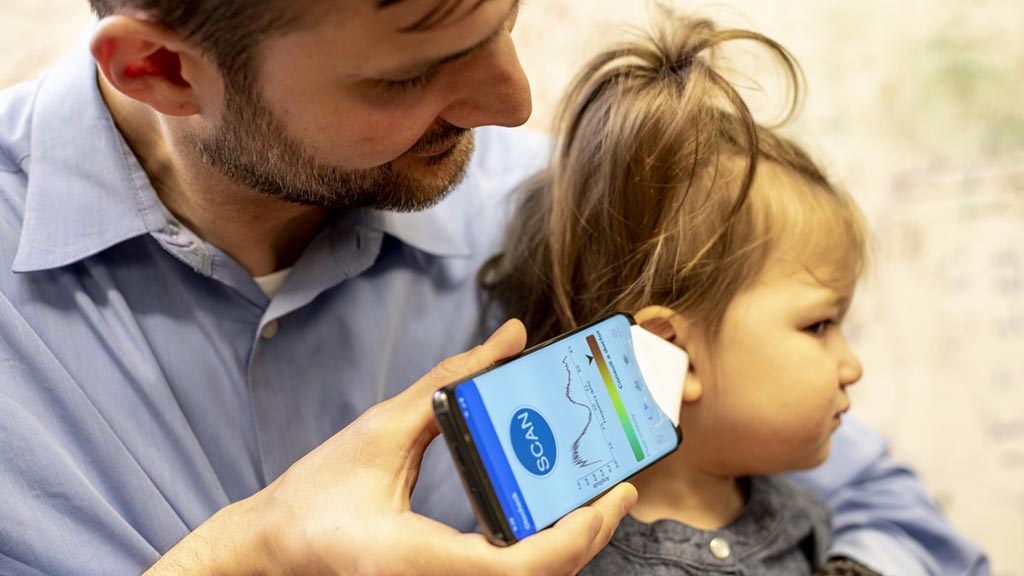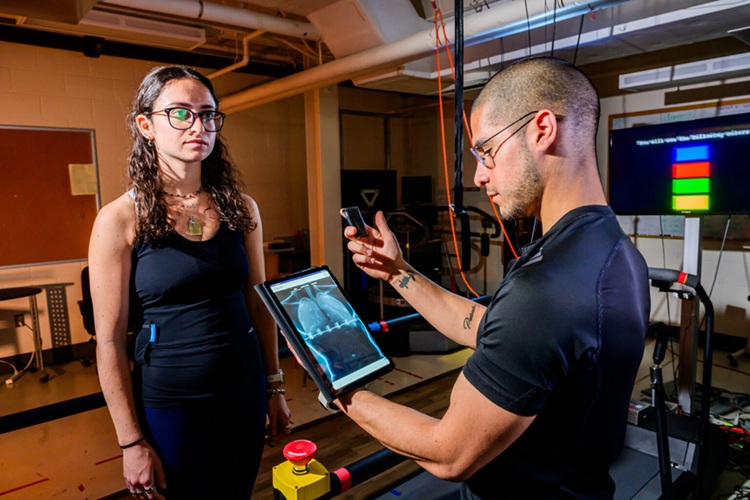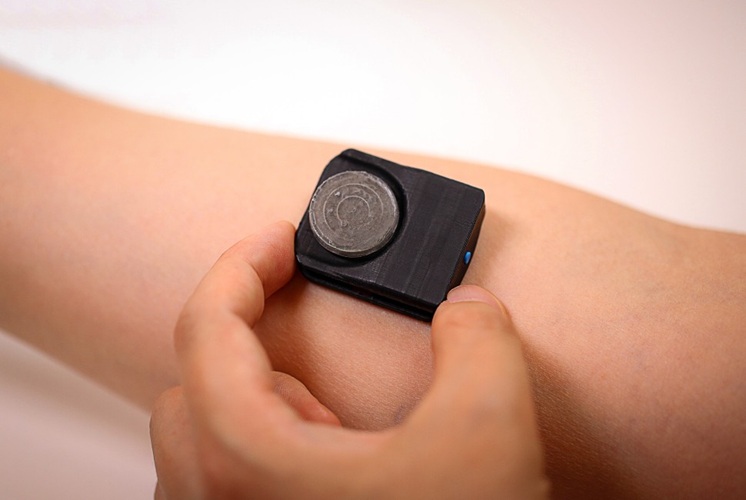Smartphone App Detects Pediatric Middle Ear Infections
|
By HospiMedica International staff writers Posted on 06 Jun 2019 |

Image: Dr. Randall Bly of Seattle Children\'s Hospital checking his daughter\'s ear (Photo courtesy of Dennis Wise/ UW).
A novel application detects middle ear fluids using the speaker of a smartphone to emit sound and the microphone to analyze its echo from the eardrum.
Developed at the University of Washington (UW; Seattle, USA) and Seattle Children’s Hospital and Research Institute (WA, USA), the app is designed to assess eardrum mobility by directing a continuous 150-millisecond soundwave into the ear using a paper funnel that rests on the outer ear. The funnel guides sound waves in and out of the ear canal to measure how they bounce off the eardrum. The sound, which resembles a bird chirping, is picked up by the smartphone's microphone along with the original chirps; the interference between the two sounds is modulated by the presence of fluid in the middle ear.
In a proof-of-concept study involving 98 pediatric patient ears, the smartphone system outperformed a commercial acoustic reflectometry system, detecting middle ear infections with a probability of 85%. In another study, the researchers tested the algorithm on 15 ears belonging to younger children between nine and 18 months of age. It correctly classified all five ears that were positive for fluid and nine out of the 10 ears (90%) that did not have fluid in them. The system can be easily operated by parents without formal medical training. The study was published on May 15, 2019, in Science Translational Medicine.
“Designing an accurate screening tool on something as ubiquitous as a smartphone can be game changing for parents as well as health care providers in resource limited regions,” said study co-author Shyam Gollakota, PhD, an associate professor in the UW School of Computer Science & Engineering. “A key advantage of our technology is that it does not require any additional hardware, other than a piece of paper and a software app running on the smartphone.”
“Fluid behind the eardrum is so common in children that there's a direct need for an accessible and accurate screening tool that can be used at home or clinical settings,” said study co-lead author Sharat Raju, MD, a resident in otolaryngology-head and neck surgery at the UW School of Medicine. “If parents could use a piece of hardware they already have to do a quick physical exam that can say ‘your child most likely doesn't have ear fluid’ or ‘your child likely has ear fluid, you should make an appointment with your pediatrician,’ that would be huge.”
Otitis media with effusion (OME) is characterized by a nonpurulent fluid effusion of the middle ear that may be either mucoid or serous. Symptoms usually involve hearing loss or aural fullness but typically do not involve pain or fever. In children, hearing loss is generally mild and is often detected only with an audiogram. In general, inpatient care for OME is not required unless complications that threaten the stability of the patient's condition are suspected.
Related Links:
University of Washington
Seattle Children’s Hospital and Research Institute
Developed at the University of Washington (UW; Seattle, USA) and Seattle Children’s Hospital and Research Institute (WA, USA), the app is designed to assess eardrum mobility by directing a continuous 150-millisecond soundwave into the ear using a paper funnel that rests on the outer ear. The funnel guides sound waves in and out of the ear canal to measure how they bounce off the eardrum. The sound, which resembles a bird chirping, is picked up by the smartphone's microphone along with the original chirps; the interference between the two sounds is modulated by the presence of fluid in the middle ear.
In a proof-of-concept study involving 98 pediatric patient ears, the smartphone system outperformed a commercial acoustic reflectometry system, detecting middle ear infections with a probability of 85%. In another study, the researchers tested the algorithm on 15 ears belonging to younger children between nine and 18 months of age. It correctly classified all five ears that were positive for fluid and nine out of the 10 ears (90%) that did not have fluid in them. The system can be easily operated by parents without formal medical training. The study was published on May 15, 2019, in Science Translational Medicine.
“Designing an accurate screening tool on something as ubiquitous as a smartphone can be game changing for parents as well as health care providers in resource limited regions,” said study co-author Shyam Gollakota, PhD, an associate professor in the UW School of Computer Science & Engineering. “A key advantage of our technology is that it does not require any additional hardware, other than a piece of paper and a software app running on the smartphone.”
“Fluid behind the eardrum is so common in children that there's a direct need for an accessible and accurate screening tool that can be used at home or clinical settings,” said study co-lead author Sharat Raju, MD, a resident in otolaryngology-head and neck surgery at the UW School of Medicine. “If parents could use a piece of hardware they already have to do a quick physical exam that can say ‘your child most likely doesn't have ear fluid’ or ‘your child likely has ear fluid, you should make an appointment with your pediatrician,’ that would be huge.”
Otitis media with effusion (OME) is characterized by a nonpurulent fluid effusion of the middle ear that may be either mucoid or serous. Symptoms usually involve hearing loss or aural fullness but typically do not involve pain or fever. In children, hearing loss is generally mild and is often detected only with an audiogram. In general, inpatient care for OME is not required unless complications that threaten the stability of the patient's condition are suspected.
Related Links:
University of Washington
Seattle Children’s Hospital and Research Institute
Latest Health IT News
- Printable Molecule-Selective Nanoparticles Enable Mass Production of Wearable Biosensors
- Smartwatches Could Detect Congestive Heart Failure
- Versatile Smart Patch Combines Health Monitoring and Drug Delivery
- Machine Learning Model Improves Mortality Risk Prediction for Cardiac Surgery Patients
- Strategic Collaboration to Develop and Integrate Generative AI into Healthcare
- AI-Enabled Operating Rooms Solution Helps Hospitals Maximize Utilization and Unlock Capacity
- AI Predicts Pancreatic Cancer Three Years before Diagnosis from Patients’ Medical Records
- First Fully Autonomous Generative AI Personalized Medical Authorizations System Reduces Care Delay
- Electronic Health Records May Be Key to Improving Patient Care, Study Finds
- AI Trained for Specific Vocal Biomarkers Could Accurately Predict Coronary Artery Disease
Channels
Critical Care
view channel
Novel Intrabronchial Method Delivers Cell Therapies in Critically Ill Patients on External Lung Support
Until now, administering cell therapies to patients on extracorporeal membrane oxygenation (ECMO)—a life-support system typically used for severe lung failure—has been nearly impossible.... Read more
Generative AI Technology Detects Heart Disease Earlier Than Conventional Methods
Detecting heart dysfunction early using cost-effective and widely accessible tools like electrocardiograms (ECGs) and efficiently directing the right patients for more expensive imaging tests remains a... Read more
Wearable Technology Predicts Cardiovascular Risk by Continuously Monitoring Heart Rate Recovery
The heart's response to physical activity is a vital early indicator of changes in health, particularly in cardiovascular function and mortality. Extensive research has demonstrated a connection between... Read more
Wearable Health Monitoring Device Measures Gases Emitted from and Absorbed by Skin
The skin plays a vital role in protecting our body from external elements. A key component of this protective function is the skin barrier, which consists of tightly woven proteins and fats that help retain... Read moreSurgical Techniques
view channel
Intravascular Imaging for Guiding Stent Implantation Ensures Safer Stenting Procedures
Patients diagnosed with coronary artery disease, which is caused by plaque accumulation within the arteries leading to chest pain, shortness of breath, and potential heart attacks, frequently undergo percutaneous... Read more
World's First AI Surgical Guidance Platform Allows Surgeons to Measure Success in Real-Time
Surgeons have always faced challenges in measuring their progress toward surgical goals during procedures. Traditionally, obtaining measurements required stepping out of the sterile environment to perform... Read morePatient Care
view channel
Portable Biosensor Platform to Reduce Hospital-Acquired Infections
Approximately 4 million patients in the European Union acquire healthcare-associated infections (HAIs) or nosocomial infections each year, with around 37,000 deaths directly resulting from these infections,... Read moreFirst-Of-Its-Kind Portable Germicidal Light Technology Disinfects High-Touch Clinical Surfaces in Seconds
Reducing healthcare-acquired infections (HAIs) remains a pressing issue within global healthcare systems. In the United States alone, 1.7 million patients contract HAIs annually, leading to approximately... Read more
Surgical Capacity Optimization Solution Helps Hospitals Boost OR Utilization
An innovative solution has the capability to transform surgical capacity utilization by targeting the root cause of surgical block time inefficiencies. Fujitsu Limited’s (Tokyo, Japan) Surgical Capacity... Read more
Game-Changing Innovation in Surgical Instrument Sterilization Significantly Improves OR Throughput
A groundbreaking innovation enables hospitals to significantly improve instrument processing time and throughput in operating rooms (ORs) and sterile processing departments. Turbett Surgical, Inc.... Read moreBusiness
view channel
Expanded Collaboration to Transform OR Technology Through AI and Automation
The expansion of an existing collaboration between three leading companies aims to develop artificial intelligence (AI)-driven solutions for smart operating rooms with sophisticated monitoring and automation.... Read more















